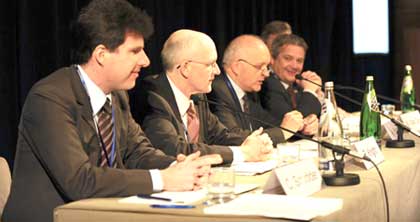
European
Nuclear Society
e-news
Issue 24 Spring 2009
http://www.euronuclear.org/e-news/e-news-24/pime2009.htm


PIME 2009, now in its twenty-first year, is a well-established fixture on the international conference calendar that has really come of age. It is totally geared to meeting the needs of communicators active in all sections of the nuclear community. Experience sharing, focused debate and, above all, practical and results-oriented communications are the name of the game. Around 150 nuclear communicators from across the world gathered for PIME 2009 in Edinburgh, from 15-18 February, to focus on real communications issues, real tools and real solutions.

The PIME 2009 programme revolved around three main plenary topics: making increasing public acceptance sustainable, managing a crisis (with special emphasis on the IAEA’s work with the INES scale) and the course of nuclear new-build in the UK. In addition, there were a number of workshops, keynote presentations on specific topics like what advertising can teach us, break-out sessions and poster exhibitions.
As usual, PIME had an impressive array of top-level speakers on hand, including public opinion analysts, advertising gurus, representatives of industry, research leaders and senior officials from the European Commission. In his welcome speech the UK government’s Minister for Scotland, Jim Murphy communicated the vision of a nuclear tomorrow in Britain clearly and unequivocally. Among the speakers of PIME 2009 were furthermore Robert Knight, Research Director of the leading public opinion analysis company, IPSOS Mori; Michel-Hubert Jamard, Director of Communications, Nuclear Division, AREVA; Kris van Dijck, Mayor of Dessel, in Belgium and Marc Michils, CEO of Saatchi and Saatchi.
The organisers brought in a number of new programme ideas that gave it a fresh and more innovative look. An innovation on the programme this year was the opportunity given to the short-listed candidates for the 2009 PIME Award for Communications Excellence to briefly present their campaigns in plenary and to lobby support from their peers. It was those fellow communications specialists who would later cast their votes. This year’s award was won by the Belgian Nuclear Forum for the first-ever extensive nuclear public advertising campaign to be run in Belgium. It used a broad range of tools, techniques and media to open a dialogue with the Belgian public and invite citizens to make up their own minds. It was all about pro-actively addressing the public and making politicians reconsider Belgium’s nuclear phase-out policy.

A new approach to focusing on diverse issues and needs of PIME delegates was based on the “open space” concept that has gained popularity at conferences in recent times. Delegates posted their choice of topic for discussion on an agenda board and fellow communicators with a common interest in a particular topic or problem gravitated together and spontaneously discussed that topic with their fellow professionals. Among the subjects that were identified and debated were “How to communicate better to young people and women,” How to manage effectively an online debate” and “How to build trust after a serious accident.”
After a morning devoted to discussions on the subject of crisis communications, the workshops on Day 2 then concentrated on other topics of perennial interest to nuclear communicators: communicating waste management, the transportation of radioactive materials (organised by the World Nuclear Transport Institute, WNTI) and a Women in Nuclear (WIN) session on engaging the public with high-impact messages. Each workshop leader then reported in plenary on what was discussed during his/her session.
Finally, after much debate and networking, Santiago San Antonio, Secretary General of ENS, announced that PIME 2010 will take place in Budapest.
For more information about the PIME2009 programme, the speakers and the winning campaign for the PIME Award for Communications Excellence go to: www.pime2009.org.
PIME delegates can also view copies of all the presentations on the Pime 2009 website.
![]()
© European Nuclear Society, 2009